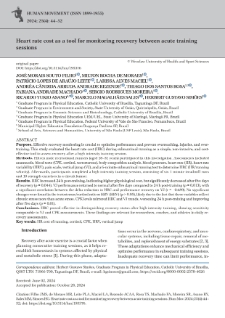Dolnośląska Biblioteka Cyfrowa udostępnia 109 165 obiektów cyfrowych
Obiekt
Tytuł: Heart rate cost as a tool for monitoring recovery between acute training sessions
Autor:
Souto Filho, Jose Morais ; De Moraes, Milton Rocha ; De Araujo Leite, Patricio Lopes ; Alves Maciel, Larissa ; Candida Arruda Andrade Rezende, Andrea ; Dos Santos Rosa, Thiago ; Andrade Machado, Fabiana ; Rodrigues Moreira, Sergio ; Yukio Asano, Ricardo ; Magalhaes Sales, Marcelo ; Simoes, Herbet Gustavo
Abstrakt:
Wydawca:
Wydawnictwo Akademii Wychowania Fizycznego im. Polskich Olimpijczyków we Wrocławiu
Miejsce wydania:
Data wydania:
Typ zasobu:
Identyfikator zasobu:
Język:
Powiązania:
Human Movement,2024, vol. 25, nr 4 ; Human Movement
Prawa:
Wszystkie prawa zastrzeżone (Copyright)
Prawa dostępu:
Dla wszystkich w zakresie dozwolonego użytku
Licencja:
CC BY-NC-ND 4.0
Właściciel praw:
Wydawnictwo Akademii Wychowania Fizycznego im. Polskich Olimpijczyków we Wrocławiu
Kolekcje, do których przypisany jest obiekt:
- Dolnośląska Biblioteka Cyfrowa > Uczestnicy Konsorcjum
- Dolnośląska Biblioteka Cyfrowa > Uczestnicy Konsorcjum > 03. Akademia Wychowania Fizycznego we Wrocławiu
- Dolnośląska Biblioteka Cyfrowa > Uczestnicy Konsorcjum > 03. Akademia Wychowania Fizycznego we Wrocławiu > Czasopisma wydawane przez Akademię Wychowania Fizycznego we Wrocławiu
- Dolnośląska Biblioteka Cyfrowa > Uczestnicy Konsorcjum > 03. Akademia Wychowania Fizycznego we Wrocławiu > Czasopisma wydawane przez Akademię Wychowania Fizycznego we Wrocławiu > Human Movement
Data ostatniej modyfikacji:
12 mar 2025
Data dodania obiektu:
22 sty 2025
Liczba wyświetleń treści obiektu:
52
Wszystkie dostępne wersje tego obiektu:
https://dlibra.kdm.wcss.pl/publication/169095
Wyświetl opis w formacie RDF:
Wyświetl opis w formacie OAI-PMH:
| Nazwa wydania | Data |
|---|---|
| Heart rate cost as a tool for monitoring recovery between acute training sessions | 12 mar 2025 |
























